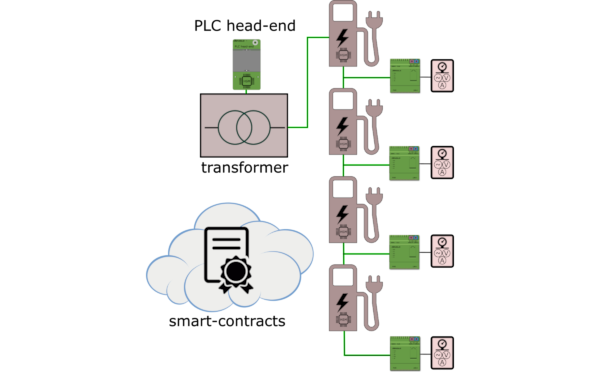Use Case 1 - Flexibility management, smart charging and grid utilization optimization with improved resiliency
Flexibility management has become an umbrella-term for a collection of different technologies. A particularly energy-intensive, interesting scenario is the smart and fast charging infrastructure for local storage and Battery Electrical Vehicles (BEV).To motivate the use-case a thorough description of the infrastructure is a good starting point.
PROGRESSUS will provide enhanced solutions to be combined in the presented use-case for i) highly efficient power conversion including storage, ii) hardware security supporting blockchain, iii) decentralized data management and ML based data processing to control the power distribution, iv) distributed energy management to maximize grid utilization and iv) efficient power line networks for high speed communication.
As depicted in the sketch, every charging station will be equipped with a powerline modem or German Smart Meter Gateway (SMGW). The power line modem will act as communication backbone and measurement platform at the same time. Data will be stored, exchanged and evaluated based on smart contracts utilizing state of the art blockchain technology. The charging stations are designed to be quickly exchangeable, only requiring a basic grid connection. The design particularly was made with minimal investment costs in mind. As each station is equipped with its own PLC-Modem, hardware security module and metrology platform, it is possible to constantly exchange data between all charging stations inside the local microgrid and/or store it inside the blockchain. The PLC-Modems will make use of hardware security modules to protect all communication via certificate-based encryption. From a data privacy perspective, all customer interaction could be subjected to perfect forward security where possible. The energy management platform that runs via smart contracts should serve two purposes: a) actual load balancing and optimal use of the microgrid, b) billing and incentivizing of customers. At the supply point for the local microgrid a PLC head-end will provide an internet uplink via wireless technologies such as LTE or CDMA or a wire bound connection such as Fiber or DSL. However, the charging infrastructure is autonomous by design. Connections to the outside world are only necessary to exchange data with the charge system operator that needs the billing information stored in the blockchain in order to do the actual financial transactions.



